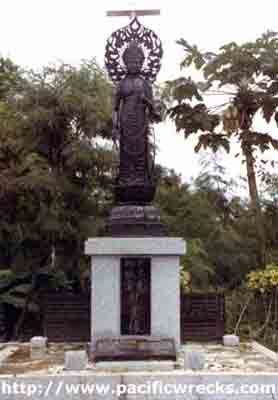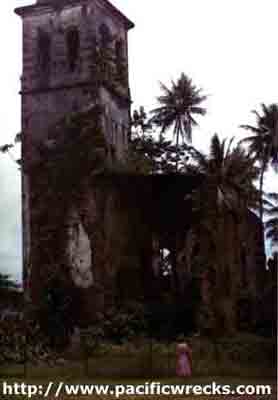Ponape
After a year in Kusaie, with work not being what I thought it would be, I moved on, and returned to Ponape, where I lived until 1973. It was during this time that I learned the details about Ponape, climbing the long end of Sokehs Mountain once with Alfred Albert to view all the barrack foundations, the searchlight emplacement and those twin-barreled ack-ack guns. That's the one with the cable control and that little hole in the roof where a single bomb penetrated, destroying the controls and rendering the guns useless.
 |
 |
 |
Langar Island
Find Ponape Harbor on the map. Above the "or" of Harbor, see Langar Island. That's where the Japanese had their seaplane base. When I was there in 1970-71, there was still an overgrown hangar with remnants of a plane inside. Under the "bor" of harbor, see Takatik Island. Aside-the letter t is pronounced ch, so this is Chakachak in Ponapean. Before the present day runway was built on Takatak for Air Micronesia jets and connected to Kolonia by another causeway, they flew a SA-16 in from Truk. (I will be sending you a slide of it taking off from Truk in 69-70). It took off on land, then landed in the harbor, and Air Mike used Langar as their seaplane base. A wonderful place to have a picnic and swim, using the concrete seaplane dock to dive off of. I know, I did it!
Japanese Airfield & Zero Wreck
Beyond that there was a Japanese airfield, (anyone could tell you wh ere it is) when I was there in the early 70's the entire skeleton frame of a large hangar was yet standing. Also revetments and storage bins, zillions of gasmasks if I recall. It was from this airfield that the shot down Zero ( a carrier Zero-I saw the tailhook) took off. Story was that it had just taken off to intercept American fighters when it was jumped. The attack was from astern and the pilot was shot once in the small of the back. The Zero flipped over on it's back and hit the ground at a slight angle. It was resting upside down, with fuse broken and tail upright. Pilot was dead at the scene. I tried to wriggle under the fuse to get into the cockpit, but the gap was just too small. I knew some American kids who went there after I told them about it. Next time I went to their house, guess what? They had chopped the tailwheel out of it and proudly displayed it to me. Airfield runways were totally overgrown with acres of elephant grass.Sokeks
Above the causeway is Sokeks (spelled Jokej). That's the place where the Japanese had several AA gun batteries.. Now on the road from Kolonia to the causeway to Sokehs, you come to a Y in the road. You can see the causeway down below if you take the right leg of the y. If you take the left y , you will finally come to the District of Kiti (pronounce Kichi). Firstly you will pass a large rectangular depression on the left side. It is ringed with black Japanese pine trees. It was a once a Japanese hospital. Down the same road heading for Kiti, after about 1-1/2 hours walk there is a crossroads. On the sw corner was then a frame(only) of a Japanese schoolhouse. It was at this crossroads that Alfred pointed down the right leg (going west) and said to me "wreckage of a B-24 down there". I know it's rough, but it's a guide however basic. If one went there and asked where the old Japanese schoolhouse on the way to Kiti was, anyone wud recall it. Then getting to that crossroads, just find anybody and ask about the plane wreck. I did not see it, but anyone I ever spoke to out there in Truk/Ponape knew exactly where every plane had crashed and could take you there or get a kid to do it. Honest! It's their back yard.There is a cab to the right of the barrels, two twin-barrel sets of naval 127mm semi-autos and one 150mm coastal gun. Operator sat in cab. This one is atop Mt. Sokehs, shot down lots of Allied planes, it was said. I was shown where one had crashed on mountain side. Maybe that B-24 wreck is from this one too. They tried B-24's bombing length of mountain top-no good, too narrow. So, they then tried bombing from side to side. Still no good, too small. I saw bomb craters from attempts on one side of Sokehs at the base. They finally got it by having a fighter (Japanese word is "sentoki") drop a small bomb which penetrated the cab and exploded inside. The hole was about 12" diameter if I recall.
Return to Dick Williams Main Page